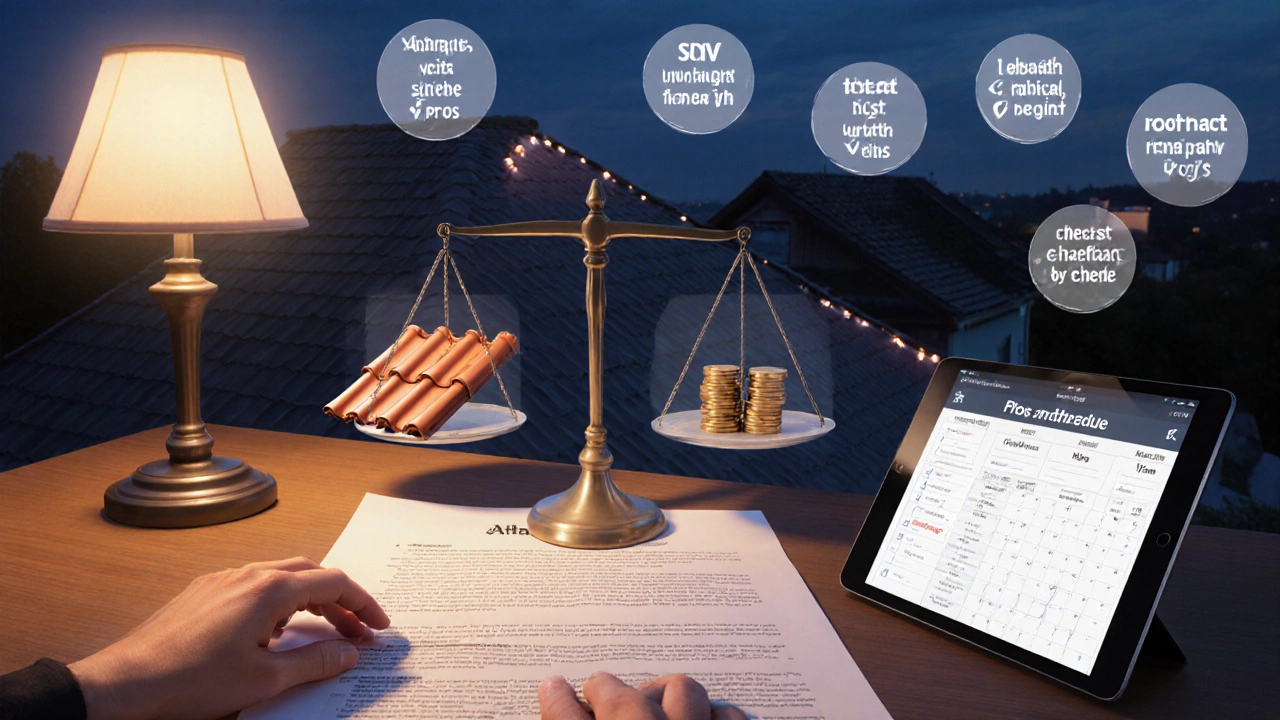What Is a Roof Payment? Explained & How It Works
 Oct, 23 2025
Oct, 23 2025
Roof Payment Calculator
Estimate monthly payments and total costs for your roof project based on different financing options. This tool helps you compare the financial impact of various payment structures.
Estimated Payments
Note: This calculation is based on the average rates from the article. Actual rates may vary based on your credit score and lender.
When homeowners talk about a roof payment is a financial arrangement that spreads the cost of a roof installation, repair, or replacement over a set period, they’re usually looking for a way to avoid a big upfront bill. roof payment options let you keep the house safe without draining your savings in one go.
Why Roof Payments Exist
Roofing is one of the most expensive single‑project items in a home improvement budget. In New Zealand, a typical slate roof replacement can cost between NZ$15,000 and NZ$30,000, while a metal roof may run NZ$20,000 to NZ$35,000. Most families don’t have that cash ready, so lenders, roofing contractors, and specialty financing companies created payment structures that break the cost into manageable chunks.
These structures also benefit contractors: they get paid faster, reduce cash‑flow concerns, and can close more jobs because the price barrier is lower for the homeowner.
Common Types of Roof Payments
- Installment plan - A direct agreement between you and the roofing contractor that splits the total invoice into equal monthly or quarterly payments, usually with little or no interest.
- Roof financing loan - A short‑term loan (often 12‑36 months) from a bank or finance company dedicated to home improvement projects. Interest rates can range from 5% to 15% APR.
- Home equity loan or line of credit (HELOC) - You borrow against the equity you’ve built in your property. Rates are usually lower than unsecured loans, but you risk your home if you default.
- Credit‑card financing - Some contractors accept credit cards, letting you benefit from rewards points or introductory 0% APR offers. Be wary of high post‑introductory rates.
- Lease‑to‑own (or roof‑as‑a‑service) - You lease the roof for a set term; at the end, you can purchase it for a nominal “balloon” payment. This model is popular with commercial projects but is creeping into residential markets.
How to Pick the Right Roof Payment Option
- Assess your budget. Calculate how much you can comfortably allocate each month without compromising other essential expenses.
- Check your credit score. A higher score unlocks lower interest rates on financing loans and HELOCs.
- Compare total cost of credit. Add up interest, fees, and any early‑payoff penalties. The lowest APR isn’t always the cheapest if the loan has high origination fees.
- Consider the roof’s lifespan. Asphalt shingles last 20‑30 years, while metal can exceed 50 years. A shorter‑term loan may make sense for a roof that will need replacement sooner.
- Read the fine print. Look for clauses about contractor defaults, lien releases, and warranty coverage linked to the payment method.
Typical Terms & Costs (NZ 2025 Snapshot)
| Payment Type | Typical Term | Interest Rate (APR) | Upfront Cost | Best For |
|---|---|---|---|---|
| Installment Plan | 6‑24 months | 0‑5% | 0-10% deposit | Homeowners who trust the contractor and want simple payments. |
| Roof Financing Loan | 12‑36 months | 5‑15% | Usually none | Those who need a fixed schedule and want to keep cash on hand. |
| HELOC | 5‑15 years (draw period) | 3‑9% | Appraisal fee only | Homeowners with significant equity and long‑term plans. |
| Credit Card | Variable (0% intro up to 12 months) | 0% intro, then 18‑24% | None | Small projects or users chasing reward points. |
| Lease‑to‑Own | 3‑7 years | Effective 8‑12% | Typically 5% down | Renters or owners who prefer low upfront cash. |
Step‑by‑Step Guide to Setting Up a Roof Payment
- Get a detailed quote. Ask the roofing contractor for a written estimate that breaks down materials, labor, and any disposal fees.
- Choose a payment method. Use the checklist above to match your financial situation with a payment type.
- Apply if needed. For loans or HELOCs, submit an application to your bank or a reputable finance company. Expect a credit check and proof of income.
- Review the contract. Ensure the payment schedule, interest rate, and any penalties are spelled out. Verify that the contractor will provide a lien waiver after each payment.
- Make the first payment. Most contractors require a deposit before ordering materials. Set up automatic transfers if possible to avoid missed payments.
- Monitor progress. Keep receipts, track the work timeline, and confirm that each payment aligns with completed milestones.
- Close out the loan. Once the roof is finished, pay off any remaining balance. Request a final lien release and keep the warranty documents.
Pros & Cons of Roof Payment Options
Installment plans are simple but may carry hidden fees if the contractor adds interest. Financing loans give you a clear interest rate but can extend the debt period. HELOCs offer low rates but put your home at risk. Credit cards are convenient for small jobs but become expensive quickly after the intro period. Lease‑to‑own reduces upfront cash but often results in a higher overall cost.

Common Pitfalls and How to Avoid Them
- Missing payments. Set up reminders or automatic debits; a missed payment can trigger late fees and even a lien.
- Not reading the fine print. Some contracts include balloon payments at the end; make sure you can handle them.
- Choosing the cheapest option without looking at total cost. A 0% credit‑card intro may seem great, but if you carry a balance for 8 months you could pay more than a low‑interest loan.
- Skipping a lien waiver. Without a waiver, the contractor could place a legal claim on your property if they aren’t paid.
- Ignoring warranty terms. Some financing offers require you to use a specific contractor; switching later could void the warranty.
Quick Summary
- A roof payment spreads the cost of a roofing job over time, making large projects affordable.
- Options include installment plans, roof financing loans, HELOCs, credit‑card financing, and lease‑to‑own.
- Compare total cost of credit, term length, and upfront requirements before deciding.
- Always get a written quote, read the contract, and secure a lien waiver.
- Set up automatic payments and keep all documentation to protect your investment.
Frequently Asked Questions
Can I use my existing home loan to pay for a new roof?
Yes, many homeowners refinance their mortgage or add a line of credit to cover roofing costs. This usually gives you a lower interest rate than a short‑term loan, but it also extends the repayment period and increases your overall debt.
Do roofing contractors charge interest on installment plans?
Some do, especially if the plan stretches beyond six months. Others offer interest‑free plans but require a higher upfront deposit. Always ask for the interest rate and any service fees before signing.
Is a lease‑to‑own roof a good idea for a single‑family home?
It can work if you lack cash and want to avoid taking on additional debt, but the total cost is usually higher than a loan. Evaluate the balloon payment at the end of the lease to ensure it fits your budget.
What documentation should I keep after the roof is installed?
Save the signed contract, payment schedule, receipts for each payment, lien waivers, warranty paperwork, and any permits. These documents are vital for future resale and for making warranty claims.
Can I combine a credit‑card offer with a contractor’s installment plan?
Technically yes, but it adds complexity and may increase fees. It’s usually smarter to choose one financing route and stick with it, unless the credit‑card rewards significantly outweigh the extra cost.
